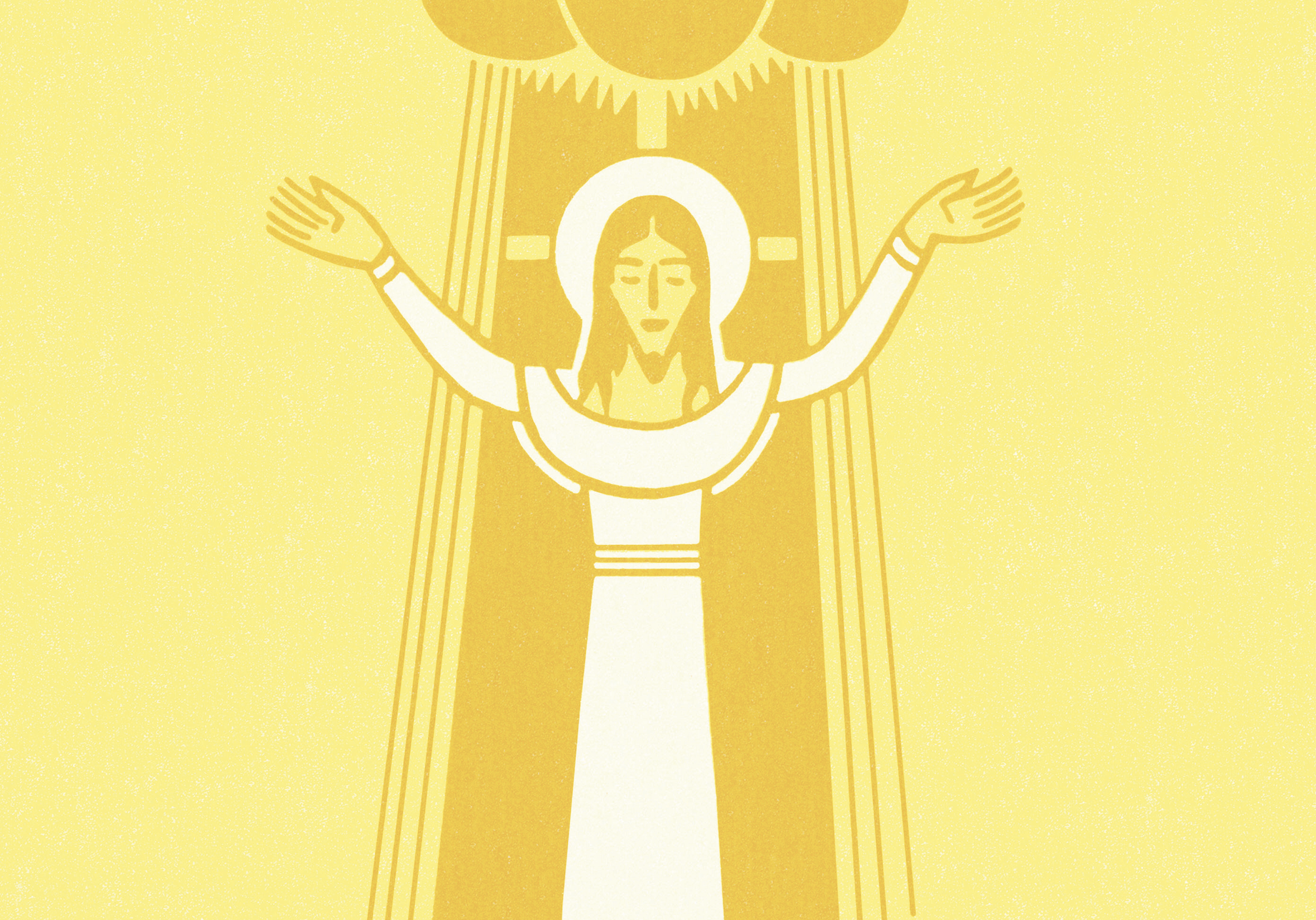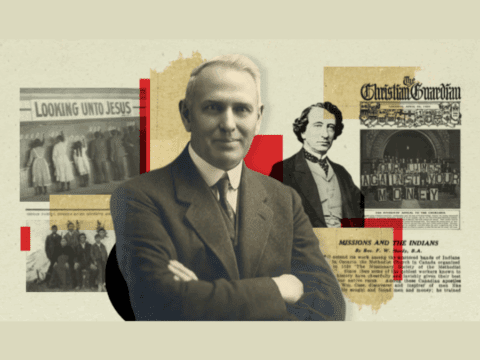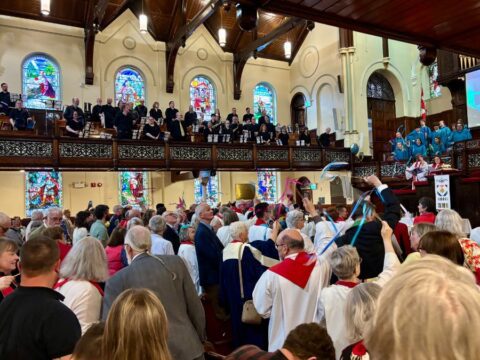My first Easter as a newly ordained minister in The United Church of Canada was in the town of Iroquois Falls, Ont., with the congregation of Trinity United. So many of the images I had of Easter had to do with spring: new life bursting forth from the ground, flowers opening to the warm sun, green shoots on the tips of branches. But it had been a long winter. The earth was still frozen as solid as a rock.
I wandered through Holy Week a bit dazed that year. I remember a Palm Parade dance with just about everyone in the congregation moving up and down the centre aisle shouting “Hosanna,” waving newspaper palm fronds and down-filled jackets. On Good Friday, after the service finished, we put a three-metre cross draped in mourning cloth in a sturdy snowbank at the front of the church. On Sunday morning, a small group gathered at sunrise, our breath making clouds in the air. We looked at each other and said, “Christ is risen. Christ is risen, indeed!” as snow fell down the backs of our necks.
I can tell you that I struggled my way through that Easter morning service. For a long time afterward, I felt like I had not served the congregation particularly well that day. And, truth be told, I hadn’t. I had gotten stuck in one way of understanding the resurrection, focusing on new life, new joy, new hope. That’s one wonderful way of understanding the resurrection, but in that moment, it wasn’t enough.
From a political perspective, I could have seen the narratives of Jesus’ death and resurrection as the story of an agitator being silenced. Jesus’ teachings were so radical, and the crowds listened to him so deeply, that those in power needed to shut him down by whatever means available. The resurrection could be seen as his message of God’s desire that the poor and oppressed be raised up and given new life — a message that continues to cause those with coercive and oppressive power to shudder to this day, if we really listen to it.
That wintery Easter morning, when everything was still frozen and there were no signs of new life, could have pushed me to see that the stories of Jesus’ resurrection were about an event outside the standard order of things.
I could have spent time looking at the accounts of the disciples’ last days with Jesus, perhaps wondering what the shock of their beloved leader’s murder would do to them. Might they have stolen the body and hid it away? Could the disciples’ grief have caused them to see and hear Jesus in the words and actions of those who were left? What would it do to our shared faith if Jesus’ resurrection didn’t happen exactly the way it’s been transmitted to us? These are the kinds of questions that get my head running full out.
I could have talked about the almost 2,000 years of people wondering about, exploring and experiencing their own responses to Jesus’ death and resurrection. From the lives of the people who came together as the earliest of Jesus’ communities, to the words of the faith leaders who wrote the historic creeds, to the discussions and debates of theologians with views far and wide, to the grandmothers and grandfathers who said to me, “I don’t know much of that academic talk, but I do know that Jesus loves me, and you, and the people I can’t stand, too.” Christians have been talking about the resurrection for as long as there have been Christians.
Then there’s the mystic in me, who might have had some interesting things to say. This is the part of me that loves the search for answers but is excited to live in the mystery of divine possibility. It’s the part that celebrates the fact that in a universe where God knows, loves and is intimately intertwined with everything that exists in all times and places, I will never be able to completely understand everything — and that Jesus’ physical resurrection is more than possible. This is the part of me that shouts with the Song of Faith of the United Church that, “God is Holy Mystery, beyond complete knowledge, above perfect description,” and sings, “We witness to the Holy Mystery that is Wholly Love!” This is the realm of miracle.
I failed my congregation that day because I took the easy way out. That wintery Easter morning, when everything was still frozen and there were no signs of new life, could have pushed me to see that the stories of Jesus’ resurrection were about an event outside the standard order of things. Even with the cold and snow of winter shouting to me that what I was sharing wasn’t the right message for this moment and these people, I didn’t explore the many different possibilities of what Jesus’ resurrection could mean for them, or for me.
Also on Broadview: Meet your new moderator: Rt. Rev. Richard Bott
The more important something is to us, the more time we need to spend looking at it from many different viewpoints. Even if we are certain that we know The One Absolutely Right Answer — or perhaps especially when we are certain — that exploration can open our eyes to possibilities we had no idea existed. Since each of us is only able to look at the world through the lens of our own experience, through our own cultural, geographic and social locations, listening to others’ interpretations helps us to understand even more about God’s world and about each other.
Exploring Easter, one of the central moments of the Christian faith, gives us the chance to learn more about the width and depth of God’s relationship with Creation and our relationship with God. Like Jesus’ birth, his life, his healings, his miracles and his teachings — there are so many layers to the story. At its core is the immensity of God’s love for all that exists. But what that immensity means, and our place in it, needs to be something that we experience and explore as individuals and with others in the world. Maybe even with a community of faith!
So pull out a Bible, or open a Bible app on your phone, and read through Mark 16, Matthew 28, Luke 24 and John 20. What do those stories say to you? What hadn’t you seen there before? Consider having a cup of coffee with someone who has a different worldview than your own and ask for her or his thoughts. Check out the work of Rev. Barbara Brown Taylor, Fr. Richard Rohr, Alydia Smith, Marjorie Hewitt Suchocki or any of the thousands of others who have shared their thoughts and experiences of Jesus. There will be things you agree with, and things you don’t. What do their understandings of Jesus say to yours?
The resurrection of Jesus Christ and our celebration of Easter is about new life, new hope and new joy, like that young minister preached that snowy Easter morning. But it’s not simply that — it’s so much more.
Rt. Rev. Richard Bott is the 43rd moderator of The United Church of Canada.
This story originally appeared in the March/April 2019 issue of The United Church Observer with the title “The many meanings of resurrection.”
To read more of Broadview’s award-winning content, subscribe to the magazine today.














